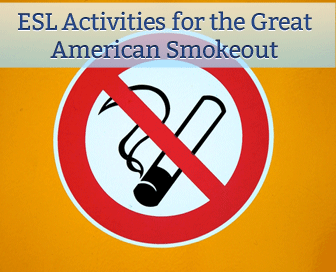ESL Activities for the Great American Smokeout (November 17)


Different cultures around the world have very different opinions of smoking, and your students will often reflect that cultural bias. Like any controversial topic, though, the issue of smoking is useful material for getting your students speaking and expressing their opinions in the classroom. Try some of the following activities with your students the next time the issue of smoking drifts into your classroom.

You can introduce the topic of smoking to your students by taking an informal survey; a simple raise of hands can tell you how many of your students are in favor of smoking and how many are opposed to the habit. Once each person has expressed which side of the debate he or she falls on, divide the class into two groups based on their opinion. Ask the anti smokers to work as a group to list all the reasons a person should not smoke. Ask the pro smokers to work together as well listing all the benefits of smoking. Challenge your students to make their lists as extensive as possible.
Once your students are thinking about the topic, give them some ideas of the bans that have been imposed on smokers in the United States. You can either gather some interesting facts from Wikipedia yourself or give your students some time to read about them on their own. How does each group feel about the bans that affect smokers? How do they affect nonsmokers? Do they think the laws are fair? Do they think any of the laws should be changed to be either less strict or more strict? How do they think these laws have affected most people’s opinions about smoking?
One of the most important aspects of persuasive speech or writing is the refutation. In the refutation, the person argues against what the opponent has argued for. Still working in your pro and con groups, give each group a copy of the arguments the other group listed for their position. Using that list, challenge both groups to come up with a refutation for each argument that the first group listed. Then, have them decide which three arguments are the strongest and write out the refutation.
If you like, this is a natural place to have your students write a persuasive essay or give a persuasive speech. Either way, students should start with an introduction, give the reasons for their side of the debate, refute the opponent’s opinions and finish with a conclusion.
Smoking tends to be portrayed in the media in a certain manner. Often, it appears sophisticated or cool, and can be very attractive to younger children or teens. Over the course of a week, challenge your students to find as many examples of smoking in the media as they can. They may bring in magazine pictures, list movie clips or commercials, quote celebrities or print pictures from the internet. As your students bring their examples in, post them on a bulletin board in your classroom titled “Smoking Hot?” The pictures, written descriptions and quotations will become a kind of gallery for your students to look at. After your students have brought several items in and the gallery wall is looking full, ask your students to take some time to look at what is posted. Then have them write an emotional reaction to what they see. How do these pictures make them feel? Do they affect the beliefs they already hold? It is important that your students understand they will not be judged on their opinion or which side of the great smoking debate they come down on. You will be reading their pieces for grammar and style as well as logical organization.
You can use a hands on demonstration to show your students the effects of smoking. If your students are older, you can have pairs of students perform the experiment themselves by giving them the instructions and the necessary materials. If your students are younger, you should perform the demonstration for them. In any case, this activity should be done outside. For each demonstration you will need one or two cotton balls, a cigarette, some clay and a plastic bottle. Have one or more students put a cotton ball inside the plastic bottle. Then cover the opening of the bottle with clay to create a plug. This bottle will represent the inside of the body and show some of the effects of smoking on the lungs. Next, poke a pencil or other object through the clay until you can see it in the bottle and insert the filter end of the cigarette in the hole. Make sure there is a tight seal as this is the mouth. Light the cigarette and squeeze the bottle about a dozen times to simulate puffing on the cigarette. Then put the cigarette out and remove the clay plug.
Once you have performed the demonstration or your students have finished the experiment on their own, ask them some questions about it. In your discussion, ask your students what happened to the cotton balls, how they look and why these were the results. Also, ask how this experiment demonstrates the effects of smoking on the body. Have each person follow the experiment by writing a summary of what they saw and what the results of the experiment were. Also, ask your students to include a personal reflection in their piece about their opinion of smoking. Do they hold the same belief they had at the beginning of the unit? Why or why not?
These activities will get your students talking and writing about the subject of smoking and perhaps influence how they view the habit.